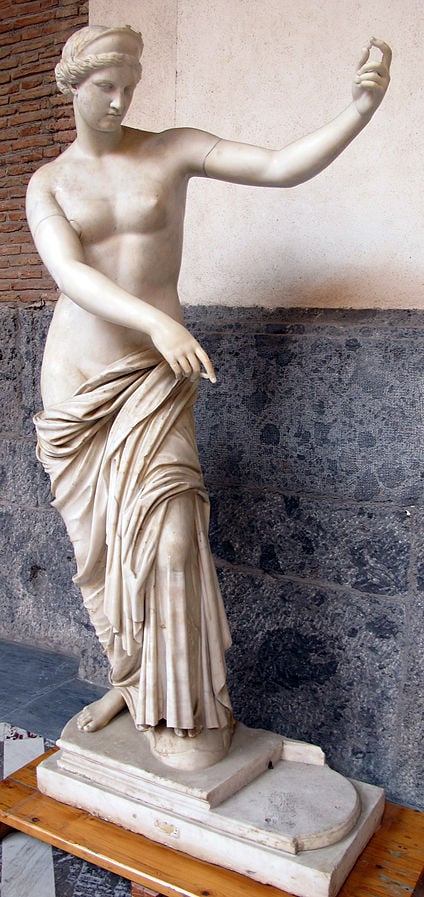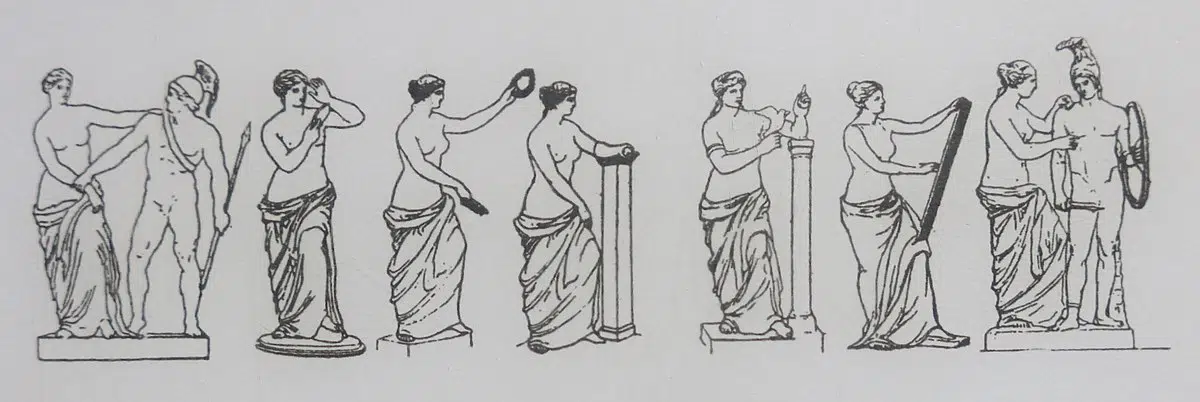
The Venus de Milo, also known as the Aphrodite of Milos, is one of the most famous sculptures to have ever come out of ancient Greece. It is immediately recognizable by its missing arms — one of the greatest mysteries in art history.
The figure, which was created with two blocks of white marble, measures 6 feet 8 inches, larger than life-size. The Venus de Milo is believed to represent the Goddess of love and beauty, Aphrodite (who is known as Venus in Roman mythology).
Its creator is unknown, but some scholars have suggested that the exquisite scupture may be the work of Alexandros of Antioch.

Why does this sculpture continue to draw so much fascination, study, and intrigue to this day? The Venus de Milo is a masterpiece and is one of the most precise and compositionally beautiful statues of the Hellenistic period. The balance it strikes between craftsmanship and allure has made it one of the most famous sculptures in the history of ancient Greece.
The piece’s lack of forearms have only deepened the aura of this fascinating figure. Its level of detail is the hallmark of this ancient Greek work of art that embodies feminine beauty in all its splendor.
The discovery of the Venus de Milo
The statue was found half-buried and in two separate pieces on April 8, 1820. The fragments were located on the Aegean island of Milos by a peasant named Yórgos Kendrotás.
Kendrotás left one half of the Venus where he had found it because he could not budge it from the ground. A French naval officer named Oliver Voutier, who had moored his ship at Milos, came to the aid of Kendrotás in excavating the sculpture only to realize that the piece was a remarkable artistic discovery.
He reported the find back to his colleagues and the French immediately began negotiating with the Ottomans, which controlled Milos at the time, for possession of the sculpture which they knew to be priceless.
What happened to the Venus de Milo’s arms?
No one knows for sure what happened to the forearms of the Aphrodite of Milos, but multiple different theories have emerged since its discovery.
A popular theory states that the arms were broken in 1820 during the fight off the coast of Milos when French and Turkish sailors competed for possession of the work of art. It is believed that the sculpture left the island by force, losing both arms when hitting the rocks; however, most scholars today believe that the sculpture’s arms were already missing when Voutier and Kendrotás found it.
Another theory claims that in 1965, the jurist Ahmed Rechim knew about the statue’s arms as he attempted to reclaim ownership of the Venus for Turkey from the Louvre Museum.
The jurist added the following information in his request: “The arms of the Venus are also buried, and the place of burial is only known to three Turkish families who pass on the secret from generation to generation. But those arms will not come to light until Venus is reintegrated into the homeland.”
The original position of the arms
Researchers across the world have debated what position the Venus de Milo’s arms were in and what activity they may have been portrayed as carrying out before they were lost.

Some believe that the right arm is holding the tunic at the hip in order to prevent the garment from slipping, while the left arm perhaps is holding the apple that was offered to Aphrodite during the judgment of Paris.
Others have speculated that she may have been leaning on a pillar or holding a crown, mirror, or shield. Other theories suggest that the statue did not represent Aphrodite at all but rather Artemis holding a bow, or possibly a Danaid holding an amphora, or even Amphitrite holding a trident.
Amphitrite was popularly worshiped on the island of Milos.
In the 1950s the “thread spool theory” emerged when an antiquities expert found that the Venus resembled another rotating statue, as well as a ceramic painting.
The American scholar and expert on archaeology Elizabeth Wayland Barber reaffirmed this theory in her book, “Women’s Work: The First 20,000 Years: Women, Cloth, and Society in Early Times,” saying that the Venus de Milo could be spinning cotton because women commonly made and wore clothing created from such fibers at the time in which the piece was created.
Perhaps we will never know the truth behind this most famous sculpture from ancient Greece; however, the mystery behind it has made it even more beautiful and intriguing. The archaeological facts surrounding the Venus’s discovery have turned this ancient statue into one of the world’s most debated masterpieces.
See all the latest news from Greece and the world at Greekreporter.com. Contact our newsroom to report an update or send your story, photos and videos. Follow GR on Google News and subscribe here to our daily email!



